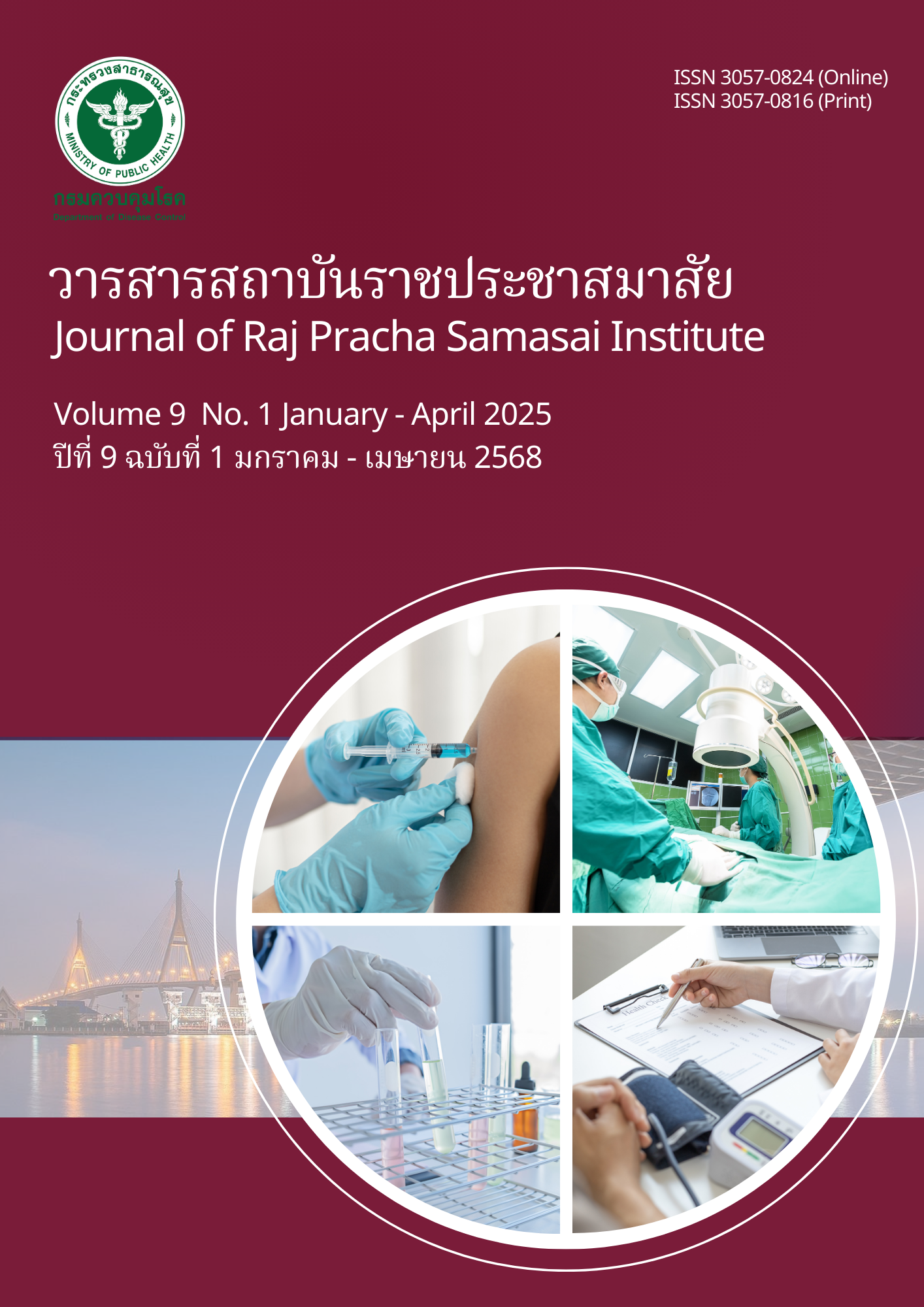การพัฒนา Digital Platform เพื่อสนับสนุนการดำเนินงานการกำจัดโรคเรื้อนในประเทศไทย
Main Article Content
บทคัดย่อ
โรคเรื้อนยังคงเป็นปัญหาสาธารณสุขที่สำคัญในประเทศไทย แม้จำนวนผู้ป่วยจะมีแนวโน้มลดลงแต่ยังคงพบอุปสรรคสำคัญ เช่น ความล่าช้าในการรายงานผู้ป่วย การขาดมาตรฐาน การสื่อสารที่ไม่ชัดเจน และข้อจำกัดทางเทคนิค ซึ่งส่งผลต่อประสิทธิภาพในการเฝ้าระวังและควบคุมโรค รวมถึงขัดขวางความพยายามระดับโลกในการกำจัดโรคเรื้อน เพื่อให้สอดคล้องกับนโยบาย Zero Leprosy ขององค์การอนามัยโลก การศึกษานี้จึงมุ่งวิเคราะห์แนวทางนวัตกรรมในการกำจัดโรคเรื้อนในประเทศไทย โดยได้ดำเนินการทบทวนข้อมูลย้อนหลัง 10 ปี (พ.ศ. 2558 - 2567) จากฐานข้อมูล PubMed และ Google Scholar โดยคัดเลือกบทความจากคำสำคัญที่เกี่ยวข้องกับแพลตฟอร์มดิจิทัล, AI, GIS และ Chatbot เพื่อพัฒนาและประเมินความเป็นไปได้ของแนวทางการใช้เทคโนโลยีสนับสนุนนโยบาย Zero Leprosy
ผลการศึกษาพบว่า มีบทความวิจัยเกี่ยวกับโรคเรื้อนใน PubMed จำนวน 7,528 บทความ ใน ScienceDirect จำนวน 9,282 บทความ และใน Google Scholar จำนวน 84,900 ใน Google Scholar โดยงานวิจัยเกี่ยวกับการใช้ AI สำหรับการตรวจคัดกรองโรคเรื้อนมีจำนวน 202, 307 และ 17,800 บทความตามลำดับ งานวิจัยเกี่ยวกับ GIS มี 11, 62 และ 5,170 บทความ และการใช้ Chatbot หรือแอปพลิเคชันมือถือมี 59, 155 และ 9,220 บทความ
งานวิจัยนี้เสนอแนวคิด Digital Platform เพื่อสนับสนุนการกำจัดโรคเรื้อนในประเทศไทย โดย AI ช่วยเพิ่มความแม่นยำในการวินิจฉัย ติดตามผู้ป่วย และเผยแพร่ข้อมูลในพื้นที่ห่างไกล ลดความล่าช้าในการรักษา และลดความเสี่ยงของความพิการ ระบบ GIS ช่วยติดตามความครอบคลุมของการรักษา เฝ้าระวังการแพร่ระบาด และเชื่อมโยงข้อมูลระหว่างหน่วยงานผ่าน Timeline และข้อมูลการเดินทางของผู้ป่วยเพื่อควบคุมการระบาดได้อย่างมีประสิทธิภาพ ส่วน Chatbot หรือแอปพลิเคชันมือถือให้ข้อมูลเกี่ยวกับโรคเรื้อน การป้องกัน และการรักษาตลอด 24 ชั่วโมง ตอบคำถามที่พบบ่อย และจัดเก็บข้อมูลสนทนาเพื่อปรับปรุงกลยุทธ์การสื่อสาร และการดูแลผู้ป่วย ดังนั้นนวัตกรรมเหล่านี้จึงมีศักยภาพในการขับเคลื่อนการกำจัดโรคเรื้อนในประเทศไทยภายใต้นโยบาย Zero Leprosy ขององค์การอนามัยโลก
Downloads
Article Details

อนุญาตภายใต้เงื่อนไข Creative Commons Attribution-NonCommercial-NoDerivatives 4.0 International License.
ประกาศเกี่ยวกับลิขสิทธิ์
บทความที่ลงพิมพ์ในวารสารสถาบันราชประชาสมาสัย ถือว่าเป็นผลงานทางวิชาการหรือการวิจัย และวิเคราะห์ตลอดจนเป็นความเห็นส่วนตัวของผู้นิพนธ์ ไม่ใช่ความเห็นกองบรรณาธิการแต่ประการใด ผู้นิพนธ์จำต้องรับผิดชอบต่อบทความของตน
นโยบายส่วนบุคคล
ชื่อและที่อยู่อีเมลที่ระบุในวารสารสถาบันราชประชาสมาสัย จะถูกใช้เพื่อวัตถุประสงค์ตามที่ระบุไว้ ในวารสารเท่านั้น และจะไม่ถูกนำไปใช้สำหรับวัตถุประสงค์อื่น หรือต่อบุคคลอื่นใด
เอกสารอ้างอิง
Department of Disease Control (TH), Rajpracha Samasai Institute. Annual Report 2023. Samut Prakan: Rajpracha Samasai Institute; 2023.
Mahotarn K, Bumpenyu S, Setkit C et al. Handbook of Leprosy Diagnosis and Treatment. 2nd ed. Bangkok: Cooperative League of Thailand; 2001.
World Health Organization. Leprosy Road Map: Strategies for Interrupting Transmission and Achieving Zero New Infections. Geneva: World Health Organization; 2021.
Mahidol University. Development of an intelligent information technology system for epidemic situations in Thailand (Thailand Epidemic AI) [Internet]. Bangkok: Mahidol University; 2024 [cited 2024 Nov 26]. Available from: https://www.mahidol.ac.th
World Health Organization. Guidelines for the diagnosis, treatment, and prevention of leprosy [Internet]. New Delhi. WHO Regional Office for South-East Asia; 2018. [Cited 2018 Oct 6] Available from: https://www.who.int/publications/i/item/97892902263830.
Bangkokbiznews. Exploring the future of public health systems: AI and innovation supporting services [Internet]. Bangkok. Bangkokbiznews; 2024 [cited 2024 Nov 26]. 1 p. Available from: https://www.bangkokbiznews.com
Zealous System. Chatbots in healthcare: enhancing patient care and operational efficiency [Internet]. Zealous system; 2024 [cited 2024 Dec 19]. Available from: https://www.zealousys.com/blog/chatbots-in-healthcare
Inferenz. Chatbot for healthcare: Key use cases, benefits & risks of AI [Internet]. Inferenz; 2023 [cited 2024 Dec 19]. Available from: https://inferenz.ai/resources/blogs/artificial-intelligence/chatbot-for-healthcare-key-use-cases-benefits-risks-of-ai/
Patel A, Waters N. Using Geographic Information Systems for Health Research [Internet]. Application of Geographic Information Systems. InTech. 2012;303-320. doi: 10.5772/47941
Robin TA, Khan MA, Kabir N, Rahaman SkT, Karim A, Mannan II, et al. Using spatial analysis and GIS to improve planning and resource allocation in a rural district of Bangladesh. BMJ Glob Health. 2019;4:e000832. doi:10.1136/bmjgh-2018-000832
Sharma R, Reddy JV. Application of GIS in Monitoring and Evaluation of Rural Development Programs in India. International Journal of Geomatics and Geosciences. 2018;8(2):123-130.


